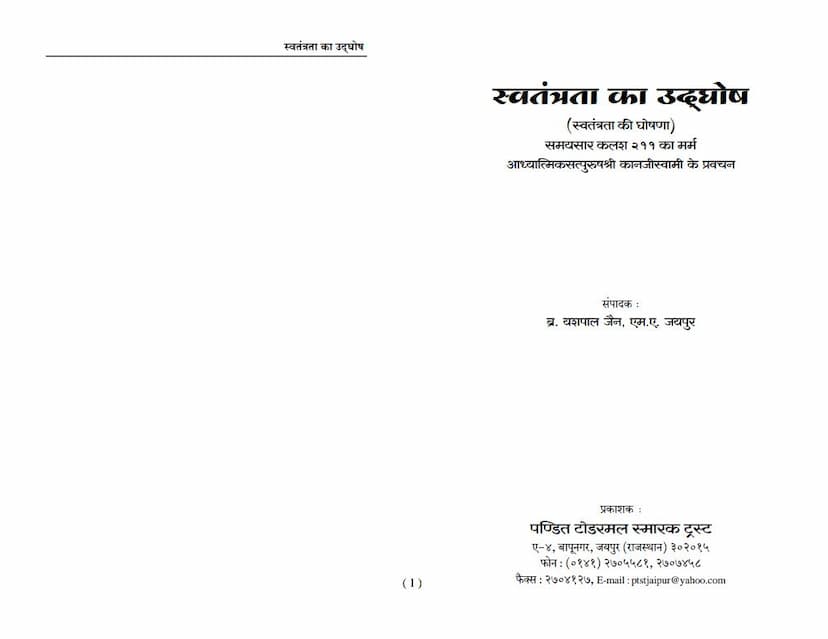Swatantrata Ka Udghosh
Added to library: September 2, 2025

Summary
Here is a comprehensive summary in English of the Jain text "Swatantrata ka Udghosh" (The Proclamation of Freedom), based on the provided text:
Book Title: Swatantrata ka Udghosh (The Proclamation of Freedom) Author: Yashpal Jain (Editor) Publisher: Todarmal Granthamala Jaipur Core Content: The book is an explanation of Shrimad Kundakundacharya's Samaysar Kalash 211, presented through the spiritual discourses of Shri Kanji Swami. It focuses on the concept of inherent freedom and self-identity of substances (dravya) as explained through a four-part analysis.
Overview: "Swatantrata ka Udghosh" is a detailed exposition of a pivotal verse (Kalash 211) from the Samaysar, a foundational Jain scripture by Acharya Kundakunda. The book, edited by Bra. Yashpal Jain, aims to elucidate the profound concept of self-reliance and independence of every substance in the universe, as revealed through the discourses of the esteemed spiritual leader, Shri Kanji Swami. The central theme is that each entity is the doer and experiencer of its own states of being, free from external influence.
Key Concepts Explained through Four Points (Four Bols):
The book meticulously breaks down the principle of self-sovereignty using four fundamental points derived from Kalash 211:
-
"Parinam ev khil karma" (Consequence/State is the action/effect):
- The text clarifies that a "karma" (action or effect) is essentially a "parinam" (state, manifestation, or modification) of a substance.
- Every substance undergoes changes and possesses various states of being. These states are not something external but are the inherent actions or manifestations of the substance itself.
- For instance, the state of knowing for the soul is its "parinam" and thus its "karma" or effect. Similarly, the state of solidity for a particle of matter is its "parinam" and its "karma."
-
"Sa bhavati parinamina ev, na aparasya bhavet" (It belongs to the possessor of the consequence/state, not to another):
- This point strongly asserts that any "parinam" (state) belongs solely to the "parinamī" (the possessor or sustainer of that state), which is the substance itself.
- The states of one substance do not arise from or belong to another substance. For example, the soul's knowledge is a state of the soul and is not caused by or dependent on language or external sounds. Similarly, the states of matter (like solidity or color) are dependent on matter itself, not on the soul.
- This principle emphasizes non-dependence and the exclusive ownership of one's own states. This realization leads to self-contemplation and the path to liberation.
-
"Na bhavati kartrshunyam iha karma na chaikataya" (Action/state does not exist without a doer, nor is the situation of the substance absolute one):
- This section highlights that no effect or state can exist without a doer ("karta"). Every "parinam" has a "karta," which is the substance itself.
- It clarifies that the soul is the doer of its spiritual states (like knowledge, faith, conduct), and matter is the doer of its physical states. The soul does not perform the states of matter, and matter does not perform the states of the soul.
- The text refutes the idea that God or any external entity is the doer of one's actions or states. Each substance is its own "Lord" or "God" in terms of its own manifestations. The soul is the doer of its own pure or impure states.
-
"Sthirirha vastuno bhavatu kartr tadev tatah" (Let the situation of the substance be that; therefore, it is the doer):
- This final point addresses the nature of the substance's existence. It states that the "situation" or state of a substance is not static or absolutely unchanging ("kutastha").
- A substance is comprised of both its inherent nature (dravya) and its ever-changing states (paryaya). While the underlying substance remains, its states are in constant flux.
- These changes or new states are not caused by external factors or combinations ("sanyog"). Instead, the substance itself, through its inherent nature, transforms into new states. The text uses analogies like water becoming hot or cold, stating that the water particles themselves have this inherent capacity to change, not the external heat or cold causing it.
Central Message and Implications:
The book, "Swatantrata ka Udghosh," through these four points, aims to instill a profound understanding of:
- Self-Reliance and Independence: Every entity in the universe is self-sufficient and independent in its own functioning and experiencing of states.
- Discrimination (Bhedgnyan): It emphasizes the critical importance of understanding the distinctness between the soul and non-soul substances, and even between different qualities within the same substance.
- The Path to Liberation (Moksha Marg): This understanding of self-sovereignty is presented as the direct path to liberation. By recognizing oneself as the sole doer and experiencer of one's states, one can shed dependence on external factors and realize their true, pure self.
- Rejection of External Agency: The discourses strongly refute any notion of an external creator or controller. Each substance is its own master.
The book is presented as a means for seekers ("mumukshu") to engage in self-study and achieve self-realization, leading to ultimate peace and happiness. It highlights the clarity and accessibility of these spiritual principles when understood correctly, even for those without extensive worldly education.